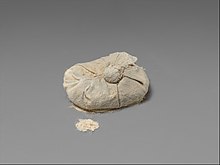Natron
Natron is a class 05 mineral (carbonate and nitrate minerals), according to the Strunz classification.
Etymology
The word comes from the Ancient Egyptian term NTR, meaning "divine" or "pure", giving rise to the compound word "divine salt". The main place of extraction of this salt was the area of Wadi Natrun, in Egypt. The word was used in Semitic languages: Akkadian nit (i) ru, Aramaic nithra, Hebrew neter נתר (for carbonate of potassium). Possibly, through Phoenician it passed into the Greek language as nitro, and into Latin as nitrum. In Arabic it is natron, a word that was transmitted to the Spanish language.
The Greek term nitro and the Latin nitrum were used for saltpeter and soda, which were not recognized as different substances.
Daniel Rutherford discovered the chemistry of nitrogen in the 18th century, although the name was given by the French chemist Chaptal, since it generated nitre; therefore, the term actually referred to two elements: nitrogen and sodium, which derive from the same word.
The Latin term natrium gave sodium its name, from which its chemical symbol Na is derived.
Properties
Chemically it is a natural sodium carbonate, highly hydrated.
It blooms rapidly when exposed to dry air, transforming into thermonatrite monohydrate (Na2CO3 H2O).
Uses
Natron was used by the ancient Egyptians in the mummification process. It was also used in the manufacture of glass ceramics: faience; In addition, this salt was destined for uses related to cleaning, such as house cleaning and body hygiene.
Formation and deposits
It forms in a sodium-rich lake environment, accumulating on its margins or as a precipitate at the bottom of the lake during cold seasons; it has also been found as efflorescence in lavas.
It usually appears associated in nature with other minerals such as: thermonatrite, trona, mirabilite, gaylussite, gypsum or calcite.
There are important deposits in Egypt and Russia.
Contenido relacionado
Benzene
Messiah
Papyrus
